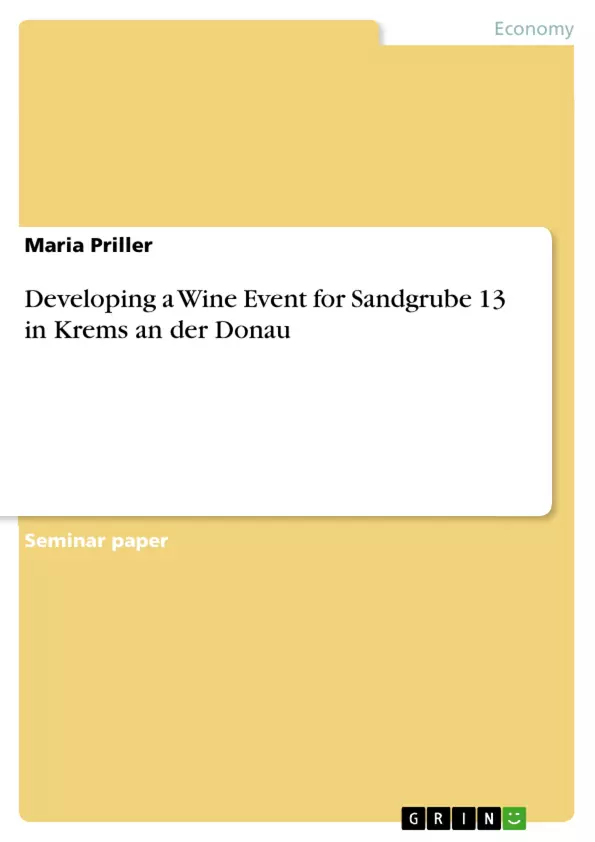This text focuses on the different aspects of a service design project of Winzer Krems, Sandgrube 13, which consists of qualitative as well as quantitative research.
We wanted to focus on a regional authentic service project that is also related to the wine culture in Krems and the Wachau valley. In addition, we were looking for a service project that is also interesting for the huge amount of younger people and students studying (and living) in Krems. Trying to find the perfect match of those two factors, the winery "Winzer Krems eG, Sandgrube 13 in 3500 Krems" came to mind.
Additionally, the fact that there is not much offered in Krems regarding the student nightlife lead us to the idea to combine the Sandgrube 13 with a students' event. That way the idea of creating a wine event for younger people/students was born!
In order to evaluate and research everything in detail, we used different methods where qualitative and quantitative research and ideation specifically were applied. Sequentially various tools we utilized to implement those methods such as a questionnaire, an in-depth interview, the stakeholder map, personas, a question wall as well as the idea clustering. During the overall creation process of the service design project, continually many small iterations have been done.
Altogether the methods and tools mentioned above helped us design a very hands-on and customer-oriented event.
Inhaltsverzeichnis (Table of Contents)
- Introduction
- Introducing Winzer Krems, Sandgrube 13
- Qualitative Research - Interview
- Research gaps
- Journey Map - Six Aspects to consider
- Interview Info & Facts
- Desktop Research
- Quantitative Research
- Results
- Personas
- Stakeholder Map
- Customer Journey Map
- Walls
- Idea Wall
- Question Wall
- Idea Portfolio
- Questionnaire
- Results
- Stakeholder Map
- Customer Journey Map
Zielsetzung und Themenschwerpunkte (Objectives and Key Themes)
This seminar paper focuses on developing a service design project for Winzer Krems, Sandgrube 13, with the aim of creating a wine event targeted at young people and students in Krems. The project aims to increase brand awareness among youth, attract a new target group, and enhance Sandgrube 13's marketing efforts. This project utilizes qualitative and quantitative research methods to gather insights and inform the design process.
- Attracting a younger target audience
- Enhancing brand awareness among youth
- Developing a wine event that appeals to students
- Improving the marketing efforts of Sandgrube 13
- Combining regional wine culture with student nightlife
Zusammenfassung der Kapitel (Chapter Summaries)
- Introduction: This chapter introduces the project's context, including the motivation behind choosing Winzer Krems, Sandgrube 13, as the subject of the service design project. It emphasizes the project's focus on regional authenticity, wine culture, and engaging a younger target audience.
- Qualitative Research - Interview: This chapter details the qualitative research conducted, including an in-depth interview with Stephan Nessl, Head of Marketing at Sandgrube 13. The interview explored various aspects of the company, its target audience, and potential areas for improvement. The chapter highlights the company's desire to attract a younger target group and increase brand popularity among youth adults.
- Quantitative Research: This chapter presents the results of the quantitative research conducted, which likely involved surveys or other data collection methods.
- Personas: This chapter focuses on the creation of personas, which are fictional representations of target customer segments. These personas are based on the insights gathered through research and provide a detailed understanding of the desired target audience.
- Stakeholder Map: This chapter describes the development of a stakeholder map, which visually represents the various stakeholders involved in the project. This map helps to identify key individuals and groups who can influence or be impacted by the project's outcomes.
- Customer Journey Map: This chapter outlines the development of a customer journey map, which visualizes the steps a customer takes when interacting with the service. This map helps identify touchpoints and opportunities for improving the customer experience.
- Walls: This chapter explores the use of "walls" as a design tool. The "Idea Wall" and "Question Wall" are likely utilized to brainstorm ideas and formulate questions during the project development process.
- Idea Portfolio: This chapter presents the resulting "Idea Portfolio," which showcases the various ideas generated during the project development phase. This portfolio likely includes potential event concepts, marketing strategies, and other solutions identified through the research and ideation process.
- Questionnaire: This chapter delves into the questionnaire used to gather data from the target audience. It likely describes the questionnaire's design, content, and its role in gathering valuable insights from potential event attendees.
Schlüsselwörter (Keywords)
The main focus of this project is on service design, wine event, young adults, students, regional authenticity, wine culture, marketing, brand awareness, target audience, qualitative research, quantitative research, stakeholder map, customer journey map, ideation, and service design tools.
- Quote paper
- Maria Priller (Author), 2018, Developing a Wine Event for Sandgrube 13 in Krems an der Donau, Munich, GRIN Verlag, https://www.grin.com/document/493789



